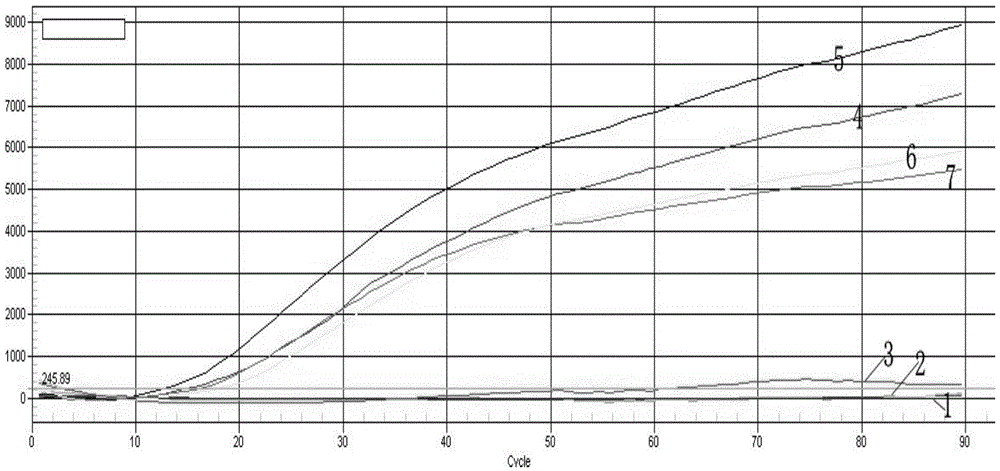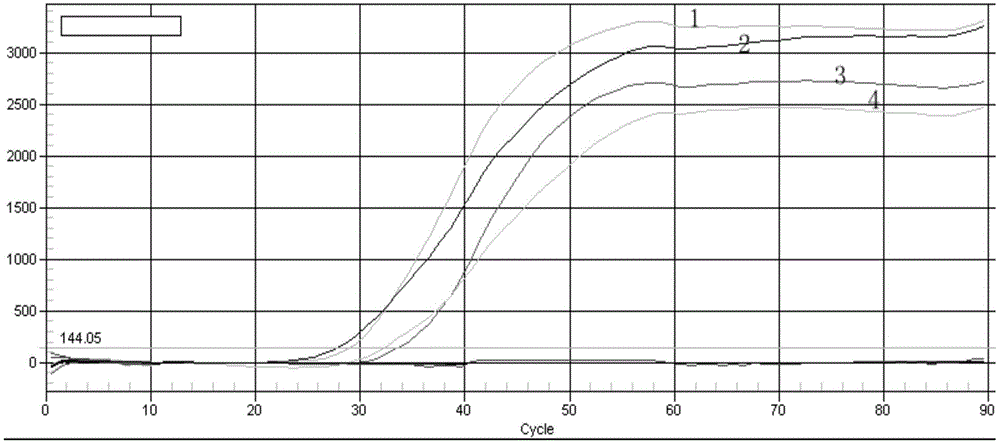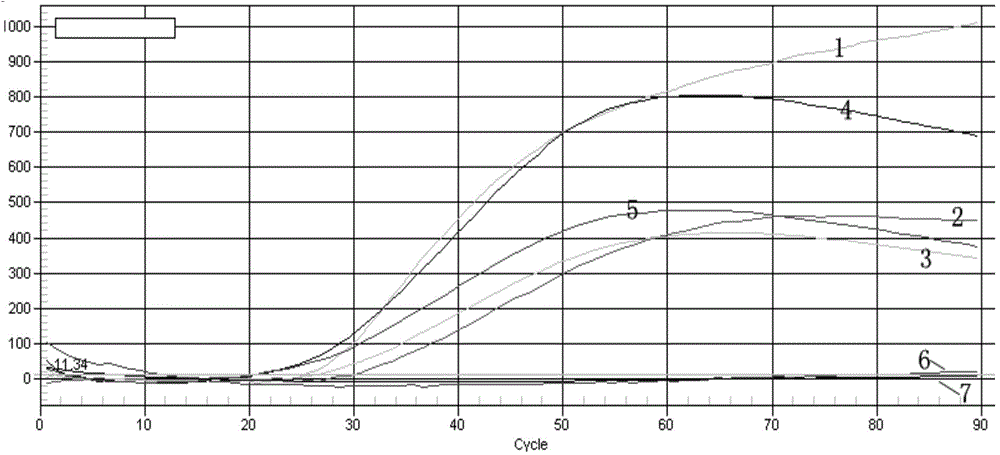Kit, primer, and probe for detecting Japanese encephalitis virus via real-time fluorescence isothermal amplification
A Japanese encephalitis virus, detection kit technology, applied in biochemical equipment and methods, microbial determination/examination, DNA/RNA fragments, etc., can solve the problem of time-consuming, low sensitivity, unsuitable for rapid detection and clinical emergency Disease treatment and other issues to achieve the effect of improving detection sensitivity and ensuring specificity
- Summary
- Abstract
- Description
- Claims
- Application Information
AI Technical Summary
Problems solved by technology
Method used
Image
Examples
Embodiment 1
[0035] Embodiment 1, the preparation of positive control substance
[0036] The virus particles were purified and harvested from the Japanese Japanese encephalitis virus cell culture medium by ultracentrifugation, and the viral RNA was extracted. The NS1 gene amplification primers N-Primer-1 and N-Primer-2 were designed, and the Japanese encephalitis Japanese encephalitis NS1 gene fragment of about 520bp was amplified by RT-PCR technology. The obtained RT-PCR product was inserted into the pGEM-4z cloning plasmid to construct the recombinant plasmid pGEM-4z-NS1, and its sequence was determined. The sequencing results were compared with 10 randomly selected Japanese encephalitis virus NS1 gene sequences of 5 different genotypes in GenBank to ensure that their homology reached more than 95%. After enrichment of positive clones, plasmid DNA was extracted, and after linearization, the inserted NS1 gene was transcribed in vitro using the T7 promoter on the plasmid to obtain single-...
Embodiment 2
[0040] Example 2, the establishment and optimization of Japanese Japanese encephalitis virus real-time fluorescent NASBA detection system
[0041] The reaction conditions were optimized for the important conditional factors affecting the real-time fluorescence NASBA detection system.
[0042] 1. Various factors and optimization methods
[0043] ① AMV buffer volume: Configure 2×NASBA reaction solution according to the reaction system in Table 1, fix other parameters, adjust the volume of AMV buffer to 2.4 μL, 2.8 μL, 3.2 μL, 3.6 μL, 4.0 μL, 4.4 μL, and use Japanese encephalitis virus In vitro transcribed RNA of NS1 gene was used as a template for real-time fluorescent NASBA amplification. After the real-time end, compare the effects of different AMV buffers on the amplification efficiency and fluorescence curve. The results are as follows: figure 1 . The volume of AMV buffer and the concentration of each component are compared in Table 3.
[0044] Table 3 AMV buffer volume ...
Embodiment 3
[0051] Embodiment 3, Japanese encephalitis virus real-time fluorescent NASBA kit components and detection method
[0052] 1. Composition of the kit (stored at -20°C)
[0053] ① 2× real-time NASBA reaction solution: containing Tris-HCl 100mM, KCl 100mM, MgCl 2 20 mM, DTT 20 mM, DMSO 20%, NTP 4 mM, dNTP 1 mM, upstream primer, downstream primer (Primer-1, Primer-2) 0.125 μM each, and molecular beacon probe (Tag1) 0.25 μM.
[0054] ②4×Enzyme Mixture: Contains AMV Reverse Transcriptase 1.6U / μL, T7 RNA Polymerase 8U / μL, Rnase H 0.04U / μL, Ribonuclease Inhibitor 2U / μL, BSA 2.0μg.
[0055] ③ Positive control: it is the RNA fragment of NS1 gene transcribed in vitro by Japanese encephalitis virus.
[0056] ④ Negative control: It is sterile physiological saline, which is extracted in parallel with the specimen at the same time as the nucleic acid extraction and used as a negative control.
[0057] ⑤ DEPC water: Nuclease-free ultrapure water treated with DEPC, used as a blank control. ...
PUM
 Login to View More
Login to View More Abstract
Description
Claims
Application Information
 Login to View More
Login to View More - R&D
- Intellectual Property
- Life Sciences
- Materials
- Tech Scout
- Unparalleled Data Quality
- Higher Quality Content
- 60% Fewer Hallucinations
Browse by: Latest US Patents, China's latest patents, Technical Efficacy Thesaurus, Application Domain, Technology Topic, Popular Technical Reports.
© 2025 PatSnap. All rights reserved.Legal|Privacy policy|Modern Slavery Act Transparency Statement|Sitemap|About US| Contact US: help@patsnap.com



